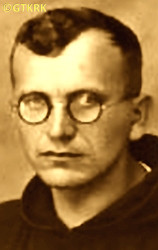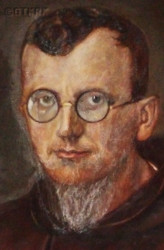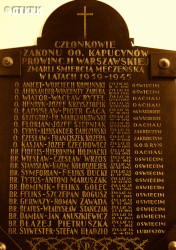Roman Catholic
St Sigismund parish
05-507 Słomczyn
85 Wiślana Str.
Konstancin deanery
Warsaw archdiocese, Poland
full list:
displayClick to display full list

searchClick to search full list by categories
wyświetlKliknij by wyświetlić pełną listę po polsku

szukajKliknij by przeszukać listę wg kategorii po polsku

Martyrology of the clergy — Poland
XX century (1914 – 1989)
personal data
surname
DARDZIŃSKI
forename(s)
Alexander (pl. Aleksander)
religious forename(s)
Cyril (pl. Cyryl)
function
religious cleric
creed
Latin (Roman Catholic) Church RCmore on
en.wikipedia.org
[access: 2014.09.21]
congregation
Order of Capuchin Friars Minor OFMCapmore on
en.wikipedia.org
[access: 2013.05.19]
(i.e. Capuchins)
diocese / province
Warsaw province OFMcapmore on
www.kapucyni.pl
[access: 2014.08.18]
date and place
of death
30.07.1944

KL Pomiechówek Fort IIIconcentration camp
today: Pomiechówek, Pomiechówek gm., Nowy Dwór Mazowiecki pov., Masovia voiv., Poland
more on
pl.wikipedia.org
[access: 2022.01.09]
details of death
After German and Russian invasion of Poland in 09.1939 and start of the World War II, during September 1938 defense war chaplain of the field hospital organized in Zakroczym monastery.
After start of German occupation and arrest of the Zakroczym monastery guardian, Fr Ceslav Kozera, in 11.1940, took over his duties becoming the only priest in the vicinity.
Collaborated with Home Army AK (part of Polish Clandestine State) — supported in financially, enabled local AK treasurer to live in the monastery, facilitate orders and reports to be exchanged in the monastery.
Arrested by the Germans on 25/26.07.1944.
Jailed in Nowy Dwór Maz.
prison, Tortured.
From there transported to Pomiechówek Fort III concentration camp where during the closure of the camp murdered.
cause of death
mass murder
perpetrators
Germans
sites and events
KL Pomiechówek Fort IIIClick to display the description, GeneralgouvernementClick to display the description, Regierungsbezirk ZichenauClick to display the description, Ribbentrop‐MolotovClick to display the description, Pius XI's encyclicalsClick to display the description
date and place
of birth
21.09.1907Birth certification on:
photos.szukajwarchiwach.gov.pl
[access: 2025.08.19]

Żebrytoday: Wąsosz gm., Grajewo pov., Podlaskie voiv., Poland
more on
en.wikipedia.org
[access: 2022.01.28]
parents
DARDZIŃSKI Adam
🞲 ?, ? — 🕆 ?, ?

BIEŃKOWSKA Stanislava
🞲 ?, ? — 🕆 ?, ?
baptism
22.09.1907Birth certification on:
photos.szukajwarchiwach.gov.pl
[access: 2025.08.19]

Wąsosztoday: Wąsosz gm., Grajewo pov., Podlaskie voiv., Poland
more on
en.wikipedia.org
[access: 2022.07.16]
Transfiguration of the Lord RC church
religious vows
15.08.1928 (temporary)
1931 (permanent)
presbyter (holy orders)
ordination
15.08.1934

Lublintoday: Lublin city pov., Lublin voiv., Poland
more on
en.wikipedia.org
[access: 2021.08.20]
positions held
1940 – 1944
guardian — Zakroczymtoday: Zakroczym gm., Nowy Dwór Mazowiecki pov., Masovia voiv., Poland
more on
en.wikipedia.org
[access: 2021.12.18] ⋄ St Lawrence the Martyr monastery, Capuchins OFMCap
1940 – 1943
administrator — Zakroczymtoday: Zakroczym gm., Nowy Dwór Mazowiecki pov., Masovia voiv., Poland
more on
en.wikipedia.org
[access: 2021.12.18] ⋄ Exaltation of the Holy Cross RC church ⋄ St Joseph RC parish ⋄ Płońsktoday: Płońsk urban gm., Płońsk pov., Masovia voiv., Poland
more on
en.wikipedia.org
[access: 2021.12.18] RC deanery
1937 – 1940
friar — Zakroczymtoday: Zakroczym gm., Nowy Dwór Mazowiecki pov., Masovia voiv., Poland
more on
en.wikipedia.org
[access: 2021.12.18] ⋄ St Lawrence the Martyr monastery, Capuchins OFMCap
till 1937
friar — Łomżatoday: Łomża city pov., Podlaskie voiv., Poland
more on
en.wikipedia.org
[access: 2022.01.28] ⋄ St Fidelis of Sigmaringen College, Capuchins OFMCap — confessor
till 1935
student — Lublintoday: Lublin city pov., Lublin voiv., Poland
more on
en.wikipedia.org
[access: 2021.08.20] ⋄ Theological Study (higher theological seminary), St Peter and St Paul the Apostles monastery, Capuchins OFMCap — prob.
till c. 1932
student — Łomżatoday: Łomża city pov., Podlaskie voiv., Poland
more on
en.wikipedia.org
[access: 2022.01.28] ⋄ Philosophical Study (higher theological seminary), Blessed Virgin Mary of Sorrows monastery, Capuchins OFMCap — prob.
1927 – 15.08.1928
novitiate — Łomżatoday: Łomża city pov., Podlaskie voiv., Poland
more on
en.wikipedia.org
[access: 2022.01.28] ⋄ Blessed Virgin Mary of Sorrows monastery, Capuchins OFMCap
14.08.1927
accession — Łomżatoday: Łomża city pov., Podlaskie voiv., Poland
more on
en.wikipedia.org
[access: 2022.01.28] ⋄ Blessed Virgin Mary of Sorrows monastery, Capuchins OFMCap
c. 1925 – 1927
pupil — Łomżatoday: Łomża city pov., Podlaskie voiv., Poland
more on
en.wikipedia.org
[access: 2022.01.28] ⋄ St Fidelis of Sigmaringen College, Capuchins OFMCap
others related
in death
KOZERAClick to display biography Francis (Fr Ceslav)
sites and events
descriptions
KL Pomiechówek Fort III: German Germ. Konzentrationslager (Eng. concentration camp) KL — formally known as Germ. Polizei Gefängnis (Eng. police prison), but also Germ. Todeslager (Eng. death camp, torture camp) or Germ. Durchgangslager (Eng. transit camp) — set‐up by Germans in military forts of Fortress Modlin n. Warsaw, largest in German occupied northern Masovia, in Germ. Regierungsbezirk Zichenau (Eng. Ciechanów Regency), part of German province Germ. Ostpreußen (Eng. East Prussia), where German state law was in force. In 1941‐1944 from 50,000 to 100,000 prisoners were held there, in atrocious conditions, mainly Poles, members of clandestine resistance organizations (part of Polish Clandestine State), but also Jews (till 1943). Thousands were murdered (including c. 6,000‐10,000 of Jews) — an unambiguous determination of the number of murdered is impossible, for from the beginning of 1944 the Germans started to wipe out the traces of the crimes. During camp closure Germans murdered all remaining inmates (apart from c. 25 women). (more on: www.dolinawkry.c0.plClick to attempt to display webpage
[access: 2013.08.17], pl.wikipedia.orgClick to attempt to display webpage
[access: 2013.06.23])
Generalgouvernement: After the Polish defeat in the 09.1939 campaign, which was the result of the Ribbentrop‐Molotov Pact and constituted the first stage of World War II, and the beginning of German occupation in part of Poland (in the other, eastern part of Poland, the Russian occupation began), the Germans divided the occupied Polish territory into five main regions. In two of them new German provinces were created, two other were incorporated into other provinces. However, the fifth part was treated separately, and in a political sense it was supposed to recreate the German idea from 1915 (during World War I, after the defeat of the Russians in the Battle of Gorlice in 05.1915) of creating a Polish enclave within Germany. Illegal in the sense of international law, i.e. Hague Convention, and public law, managed by the Germans according to separate laws — especially established for the Polish Germ. Untermenschen (Eng. subhumans) — till the Russian offensive in 1945 it constituted part of the Germ. Großdeutschland (Eng. Greater Germany). Till 31.07.1940 formally called Germ. Generalgouvernement für die besetzten polnischen Gebiete (Eng. General Government for the occupied Polish lands) — later simply Germ. Generalgouvernement (Eng. General Governorate), as in the years 1915‐1918. From 07.1941, i.e. after the German attack on 22.06.1941 against the erstwhile ally, the Russians, it also included the Galicia district, i.e. the Polish pre‐war south‐eastern voivodeships. A special criminal law was enacted and applied to Poles and Jews, allowing for the arbitrary administration of the death penalty regardless of the age of the „perpetrator”, and sanctioning the use of collective responsibility. After the end of the military conflict of the World War UU, the government of the Germ. Generalgouvernement was recognized as a criminal organization, and its leader, governor Hans Frank, guilty of war crimes and crimes against humanity and executed. (more on: en.wikipedia.orgClick to attempt to display webpage
[access: 2024.12.13])
Regierungsbezirk Zichenau: After the Polish defeat in the 09.1939 campaign, which was the result of the Ribbentrop‐Molotov Pact and constituted the first stage of World War II, and the beginning of German occupation in part of Poland (in the other, eastern part of Poland, the Russian occupation began), the Germans divided the occupied Polish territory into five main regions (and a few smaller). The largest one was transformed into Germ. Generalgouvernement (Eng. General Governorate), intended exclusively for Poles and Jews and constituting part of the so‐called Germ. Großdeutschland (Eng. Greater Germany). From two separate new provinces were created. The two remaining were incorporated into existing German provinces. One of those was the Germ. Regierungsbezirk Zichenau (Eng. Ciechanów regency), created from part of the occupied Warsaw voivodeship, and incorporated into the Germ. Provinz Ostpreußen (Eng. East Prussia) — on the basis of the decree of the German leader Adolf Hitler of 08.10.1939 (formally in force from 26.10.1939) — in which the law of the German state was applicable. The main axis of the policy of the new regency, the territory of which the Germans recognized as the Germ. „Ursprünglich Deutsche” (Eng. „natively German”), despite the fact only 6% of its pre–war Polish part were Germans, was Germ. „Entpolonisierung” (Eng. „Depolonisation”), i.e. forced Germanization, and Germ. Zwangsarbeit (Eng. forced slave labor). Most of the Germ. Zivilarbeiter (Eng. civilian worker) slaved in the Germ. Provinz Ostpreußen. Some Poles— c. 25,000 — were deported to the Germ. Generalgouvernement; some were sent to concentration camps. Children could only learn in German. A policy of terror was pursued against the Polish population — 8 large prisons operated in a small area, Polish organizations and institutions were closed. The Polish press was liquidated. Of the 200 arrested Catholic priests from the Płock diocese, 110 were murdered. Most parishes were left without pastors — only a few priests per county were allowed to serve. Conducting services, sermons and confessions in Polish was prohibited. Churches were plundered and turned into warehouses. Catholic funerals with more than 10 people were prohibited. Crosses, roadside shrines, tombstones and cemeteries were destroyed. After the end of hostilities of World War II, the overseer of this province, the Germ. Reichsstatthalter (Eng. Reich Governor) and the Germ. Gauleiter (Eng. district head) of the German National Socialist Party, Erich Koch, initially went into hiding, then was captured and extradited to the Commie–Nazi republic of Poland prl, sentenced to death, but the sentence was not carried out and died in prison in 1986. The Germ. Regierungspräsidenten Zichenau (Eng. superpresident of the Ciechanów regency) hid better and his post‐war fate is still unknown. (more on: en.wikipedia.orgClick to attempt to display webpage
[access: 2024.06.24])
Ribbentrop‐Molotov: Genocidal Russian‐German alliance pact between Russian leader Joseph Stalin and German leader Adolf Hitler signed on 23.08.1939 in Moscow by respective foreign ministers, Mr. Vyacheslav Molotov for Russia and Joachim von Ribbentrop for Germany. The pact sanctioned and was the direct cause of joint Russian and German invasion of Poland and the outbreak of the World War II in 09.1939. In a political sense, the pact was an attempt to restore the status quo ante before 1914, with one exception, namely the „commercial” exchange of the so‐called „Kingdom of Poland”, which in 1914 was part of the Russian Empire, fore Eastern Galicia (today's western Ukraine), in 1914 belonging to the Austro‐Hungarian Empire. Galicia, including Lviv, was to be taken over by the Russians, the „Kingdom of Poland” — under the name of the General Governorate — Germany. The resultant „war was one of the greatest calamities and dramas of humanity in history, for two atheistic and anti‐Christian ideologies — national and international socialism — rejected God and His fifth Decalogue commandment: Thou shall not kill!” (Abp Stanislav Gądecki, 01.09.2019). The decisions taken — backed up by the betrayal of the formal allies of Poland, France and Germany, which on 12.09.1939, at a joint conference in Abbeville, decided not to provide aid to attacked Poland and not to take military action against Germany (a clear breach of treaty obligations with Poland) — were on 28.09.1939 slightly altered and made more precise when a treaty on „German‐Russian boundaries and friendship” was agreed by the same murderous signatories. One of its findings was establishment of spheres of influence in Central and Eastern Europe and in consequence IV partition of Poland. In one of its secret annexes agreed, that: „the Signatories will not tolerate on its respective territories any Polish propaganda that affects the territory of the other Side. On their respective territories they will suppress all such propaganda and inform each other of the measures taken to accomplish it”. The agreements resulted in a series of meeting between two genocidal organization representing both sides — German Gestapo and Russian NKVD when coordination of efforts to exterminate Polish intelligentsia and Polish leading classes (in Germany called «Intelligenzaktion», in Russia took the form of Katyń massacres) where discussed. Resulted in deaths of hundreds of thousands of Polish intelligentsia, including thousands of priests presented here, and tens of millions of ordinary people,. The results of this Russian‐German pact lasted till 1989 and are still in evidence even today. (more on: en.wikipedia.orgClick to attempt to display webpage
[access: 2015.09.30])
Pius XI's encyclicals: Facing the creation of two totalitarian systems in Europe, which seemed to compete with each other, though there were more similarities than contradictions between them, Pope Pius XI issued in 03.1937 (within 5 days) two encyclicals. In the „Mit brennender Sorge” (Eng. „With Burning Concern”) published on 14.03.1938, condemned the national socialism prevailing in Germany. The Pope wrote: „Whoever, following the old Germanic‐pre‐Christian beliefs, puts various impersonal fate in the place of a personal God, denies the wisdom of God and Providence […], whoever exalts earthly values: race or nation, or state, or state system, representatives of state power or other fundamental values of human society, […] and makes them the highest standard of all values, including religious ones, and idolizes them, this one […] is far from true faith in God and from a worldview corresponding to such faith”. On 19.03.1937, published „Divini Redemptoris” (Eng. „Divine Redeemer”), in which criticized Russian communism, dialectical materialism and the class struggle theory. The Pope wrote: „Communism deprives man of freedom, and therefore the spiritual basis of all life norms. It deprives the human person of all his dignity and any moral support with which he could resist the onslaught of blind passions […] This is the new gospel that Bolshevik and godless communism preaches as a message of salvation and redemption of humanity”… Pius XI demanded that the established human law be subjected to the natural law of God , recommended the implementation of the ideal of a Christian state and society, and called on Catholics to resist. Two years later, National Socialist Germany and Communist Russia came together and started World War II. (more on: www.vatican.vaClick to attempt to display webpage
[access: 2023.05.28], www.vatican.vaClick to attempt to display webpage
[access: 2023.05.28])
sources
personal:
www.oat.com.plClick to attempt to display webpage
[access: 2012.12.28], regis.maxus.com.plClick to attempt to display webpage
[access: 2012.12.28], www.powolanie-kapucyni.plClick to attempt to display webpage
[access: 2017.11.07], photos.szukajwarchiwach.gov.plClick to attempt to display webpage
[access: 2025.08.19]
original images:
regis.maxus.com.plClick to attempt to display webpage
[access: 2012.12.28], www.powolanie-kapucyni.plClick to attempt to display webpage
[access: 2017.11.07]
LETTER to CUSTODIAN/ADMINISTRATOR
If you have an Email client on your communicator/computer — such as Mozilla Thunderbird, Windows Mail or Microsoft Outlook, described at WikipediaPatrz:
en.wikipedia.org, among others — try the link below, please:
LETTER to CUSTODIAN/ADMINISTRATORClick and try to call your own Email client
If however you do not run such a client or the above link is not active please send an email to the Custodian/Administrator using your account — in your customary email/correspondence engine — at the following address:

giving the following as the subject:
MARTYROLOGY: DARDZIŃSKI Alexander
To return to the biography press below:
 Click to return to biography
Click to return to biography










